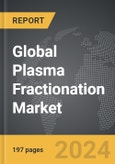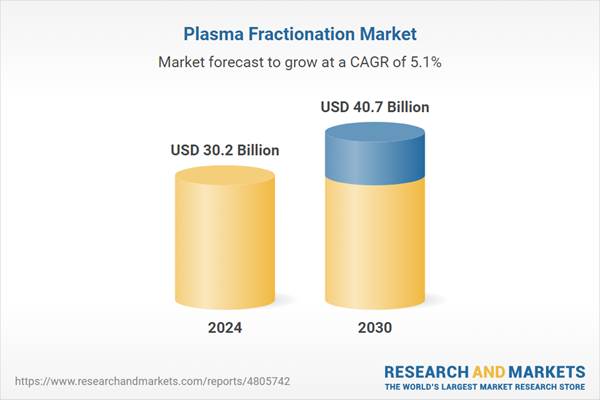The global market for Plasma Fractionation was valued at US$30.2 Billion in 2024 and is projected to reach US$40.7 Billion by 2030, growing at a CAGR of 5.1% from 2024 to 2030. This comprehensive report provides an in-depth analysis of market trends, drivers, and forecasts, helping you make informed business decisions. The report includes the most recent global tariff developments and how they impact the Plasma Fractionation market.
Segments: Product (Immunoglobulins, Albumin, Coagulation Factor Concentrates, Protease Inhibitors, Other Products); Application (Neurology, Immunology, Hematology, Oncology, Pulmonology, Other Applications); End-Use (Hospitals & Clinics, Clinical Research Laboratories, Academic Institutes).
Geographic Regions/Countries: World; United States; Canada; Japan; China; Europe (France; Germany; Italy; United Kingdom; and Rest of Europe); Asia-Pacific; Rest of World.
The analysts continuously track trade developments worldwide, drawing insights from leading global economists and over 200 industry and policy institutions, including think tanks, trade organizations, and national economic advisory bodies. This intelligence is integrated into forecasting models to provide timely, data-driven analysis of emerging risks and opportunities.
Global Plasma Fractionation Market - Key Trends and Drivers Summarized
Harnessing Vital Proteins: The Process of Plasma Fractionation
Plasma fractionation is a sophisticated biotechnological process used to separate and purify different components from blood plasma. Plasma, the liquid portion of blood, contains a variety of proteins and other substances essential for medical treatments. The fractionation process begins with the collection of plasma through donation. Once collected, the plasma undergoes a series of steps, including centrifugation, filtration, and chromatography, to isolate specific proteins. These proteins, such as albumin, immunoglobulins, and clotting factors, are then purified and concentrated for therapeutic use. Each step in the fractionation process is carefully controlled to ensure the purity, efficacy, and safety of the final products, which are used to treat a range of medical conditions, from immune deficiencies and bleeding disorders to shock and trauma.How Are Plasma-Derived Products Utilized in Medicine?
Plasma-derived products play a critical role in modern medicine, offering life-saving treatments for various conditions. Albumin, one of the major proteins isolated through plasma fractionation, is used to treat patients with severe burns, liver diseases, and hypoalbuminemia by helping maintain blood volume and pressure. Immunoglobulins, or antibodies, are essential for treating immune deficiencies and autoimmune diseases. They provide passive immunity to patients, enhancing their ability to fight infections. Clotting factors, such as Factor VIII and Factor IX, are crucial for patients with hemophilia, a genetic disorder that impairs blood clotting. These products help prevent and control bleeding episodes, significantly improving the quality of life for hemophilia patients. The diverse applications of plasma-derived products underscore their importance in addressing a wide range of medical needs and enhancing patient care.What Are the Current Trends in Plasma Fractionation Technology?
The plasma fractionation industry is continuously evolving, driven by advancements in technology and a growing understanding of plasma proteins. One significant trend is the improvement in purification techniques, such as advanced chromatography and filtration methods, which enhance the yield and purity of plasma-derived products. Another trend is the development of recombinant DNA technology, which allows for the production of certain plasma proteins in a laboratory setting, reducing dependence on plasma donations and increasing the availability of these critical therapies. The integration of automation and digital technologies is also transforming plasma fractionation, enabling more efficient and scalable production processes. Additionally, there is a growing focus on expanding the range of therapeutic applications for plasma-derived products, including the treatment of emerging diseases and conditions. These technological advancements and innovative approaches are shaping the future of plasma fractionation, making therapies more effective and accessible.What Factors Are Driving the Growth in the Plasma Fractionation Market?
The growth in the plasma fractionation market is driven by several factors, each reflecting the increasing demand for plasma-derived therapies. The rising prevalence of chronic diseases and genetic disorders, such as hemophilia and primary immune deficiencies, is a significant driver, as these conditions require regular and long-term treatment with plasma-derived products. Technological advancements in fractionation processes and the development of recombinant therapies are enhancing the efficiency and scalability of production, meeting the growing demand. The expansion of healthcare infrastructure in developing regions is increasing access to plasma-derived therapies, contributing to market growth. Additionally, the aging global population is driving demand for treatments for age-related conditions, such as liver disease and immunodeficiencies. The emphasis on improving patient outcomes and the ongoing research into new therapeutic applications for plasma proteins further support market expansion. These factors collectively ensure robust growth in the plasma fractionation market, highlighting its critical role in modern healthcare and therapeutic development.Report Scope
The report analyzes the Plasma Fractionation market, presented in terms of units. The analysis covers the key segments and geographic regions outlined below.Segments: Product (Immunoglobulins, Albumin, Coagulation Factor Concentrates, Protease Inhibitors, Other Products); Application (Neurology, Immunology, Hematology, Oncology, Pulmonology, Other Applications); End-Use (Hospitals & Clinics, Clinical Research Laboratories, Academic Institutes).
Geographic Regions/Countries: World; United States; Canada; Japan; China; Europe (France; Germany; Italy; United Kingdom; and Rest of Europe); Asia-Pacific; Rest of World.
Key Insights:
- Market Growth: Understand the significant growth trajectory of the Immunoglobulins segment, which is expected to reach US$14.8 Billion by 2030 with a CAGR of a 6.5%. The Albumin segment is also set to grow at 4.3% CAGR over the analysis period.
- Regional Analysis: Gain insights into the U.S. market, valued at $8.1 Billion in 2024, and China, forecasted to grow at an impressive 4.8% CAGR to reach $6.4 Billion by 2030. Discover growth trends in other key regions, including Japan, Canada, Germany, and the Asia-Pacific.
Why You Should Buy This Report:
- Detailed Market Analysis: Access a thorough analysis of the Global Plasma Fractionation Market, covering all major geographic regions and market segments.
- Competitive Insights: Get an overview of the competitive landscape, including the market presence of major players across different geographies.
- Future Trends and Drivers: Understand the key trends and drivers shaping the future of the Global Plasma Fractionation Market.
- Actionable Insights: Benefit from actionable insights that can help you identify new revenue opportunities and make strategic business decisions.
Key Questions Answered:
- How is the Global Plasma Fractionation Market expected to evolve by 2030?
- What are the main drivers and restraints affecting the market?
- Which market segments will grow the most over the forecast period?
- How will market shares for different regions and segments change by 2030?
- Who are the leading players in the market, and what are their prospects?
Report Features:
- Comprehensive Market Data: Independent analysis of annual sales and market forecasts in US$ Million from 2024 to 2030.
- In-Depth Regional Analysis: Detailed insights into key markets, including the U.S., China, Japan, Canada, Europe, Asia-Pacific, Latin America, Middle East, and Africa.
- Company Profiles: Coverage of players such as Bio Products Laboratory Ltd., Biotest AG, China Biologic Products, Inc., CSL Limited, Green Cross Corporation and more.
- Complimentary Updates: Receive free report updates for one year to keep you informed of the latest market developments.
Some of the 47 companies featured in this Plasma Fractionation market report include:
- Bio Products Laboratory Ltd.
- Biotest AG
- China Biologic Products, Inc.
- CSL Limited
- Green Cross Corporation
- Grifols SA
- Japan Blood Products Organization
- Kedrion SpA
- LFB SA
- Octapharma AG
- Sanquin
- Shanghai RAAS Blood Products Co., Ltd.
- Shire PLC
Tariff Impact Analysis: Key Insights for 2025
Global tariff negotiations across 180+ countries are reshaping supply chains, costs, and competitiveness. This report reflects the latest developments as of April 2025 and incorporates forward-looking insights into the market outlook.The analysts continuously track trade developments worldwide, drawing insights from leading global economists and over 200 industry and policy institutions, including think tanks, trade organizations, and national economic advisory bodies. This intelligence is integrated into forecasting models to provide timely, data-driven analysis of emerging risks and opportunities.
What’s Included in This Edition:
- Tariff-adjusted market forecasts by region and segment
- Analysis of cost and supply chain implications by sourcing and trade exposure
- Strategic insights into geographic shifts
Buyers receive a free July 2025 update with:
- Finalized tariff impacts and new trade agreement effects
- Updated projections reflecting global sourcing and cost shifts
- Expanded country-specific coverage across the industry
Table of Contents
I. METHODOLOGYII. EXECUTIVE SUMMARY2. FOCUS ON SELECT PLAYERSIII. MARKET ANALYSISCANADAITALYREST OF EUROPEREST OF WORLDIV. COMPETITION
1. MARKET OVERVIEW
3. MARKET TRENDS & DRIVERS
4. GLOBAL MARKET PERSPECTIVE
UNITED STATES
JAPAN
CHINA
EUROPE
FRANCE
GERMANY
UNITED KINGDOM
ASIA-PACIFIC
Companies Mentioned (Partial List)
A selection of companies mentioned in this report includes, but is not limited to:
- Bio Products Laboratory Ltd.
- Biotest AG
- China Biologic Products, Inc.
- CSL Limited
- Green Cross Corporation
- Grifols SA
- Japan Blood Products Organization
- Kedrion SpA
- LFB SA
- Octapharma AG
- Sanquin
- Shanghai RAAS Blood Products Co., Ltd.
- Shire PLC
Table Information
| Report Attribute | Details |
|---|---|
| No. of Pages | 245 |
| Published | April 2025 |
| Forecast Period | 2024 - 2030 |
| Estimated Market Value ( USD | $ 30.2 Billion |
| Forecasted Market Value ( USD | $ 40.7 Billion |
| Compound Annual Growth Rate | 5.1% |
| Regions Covered | Global |









